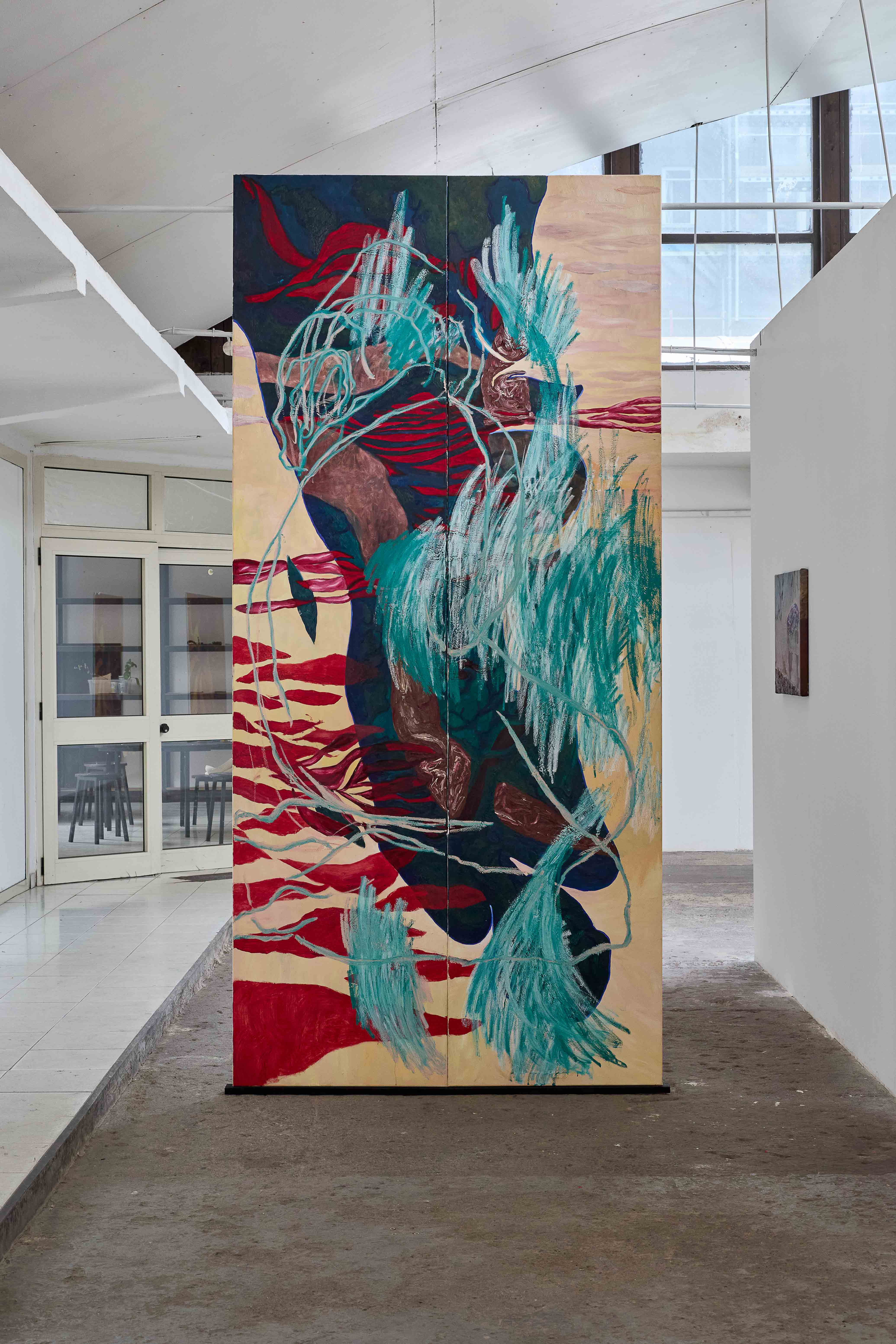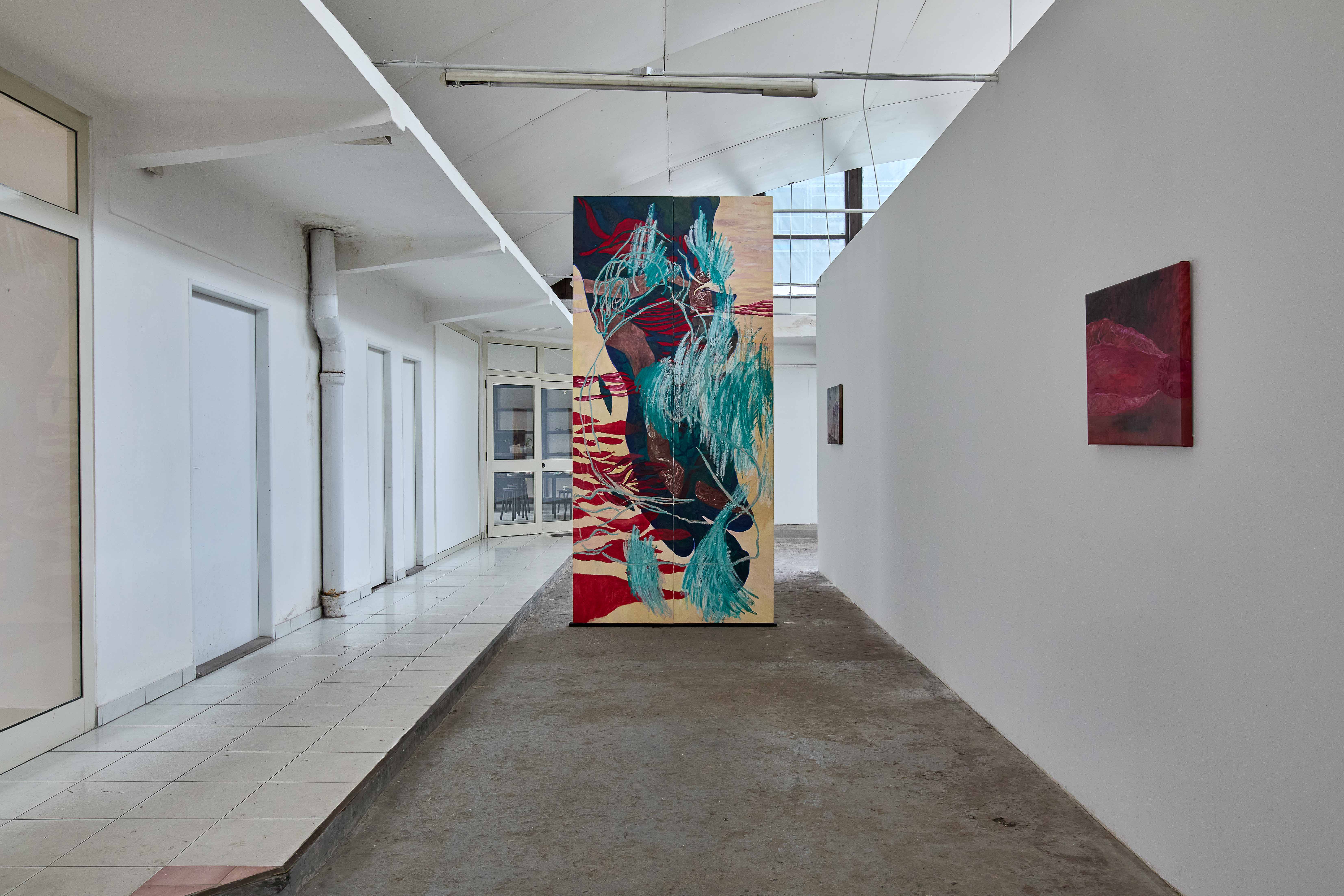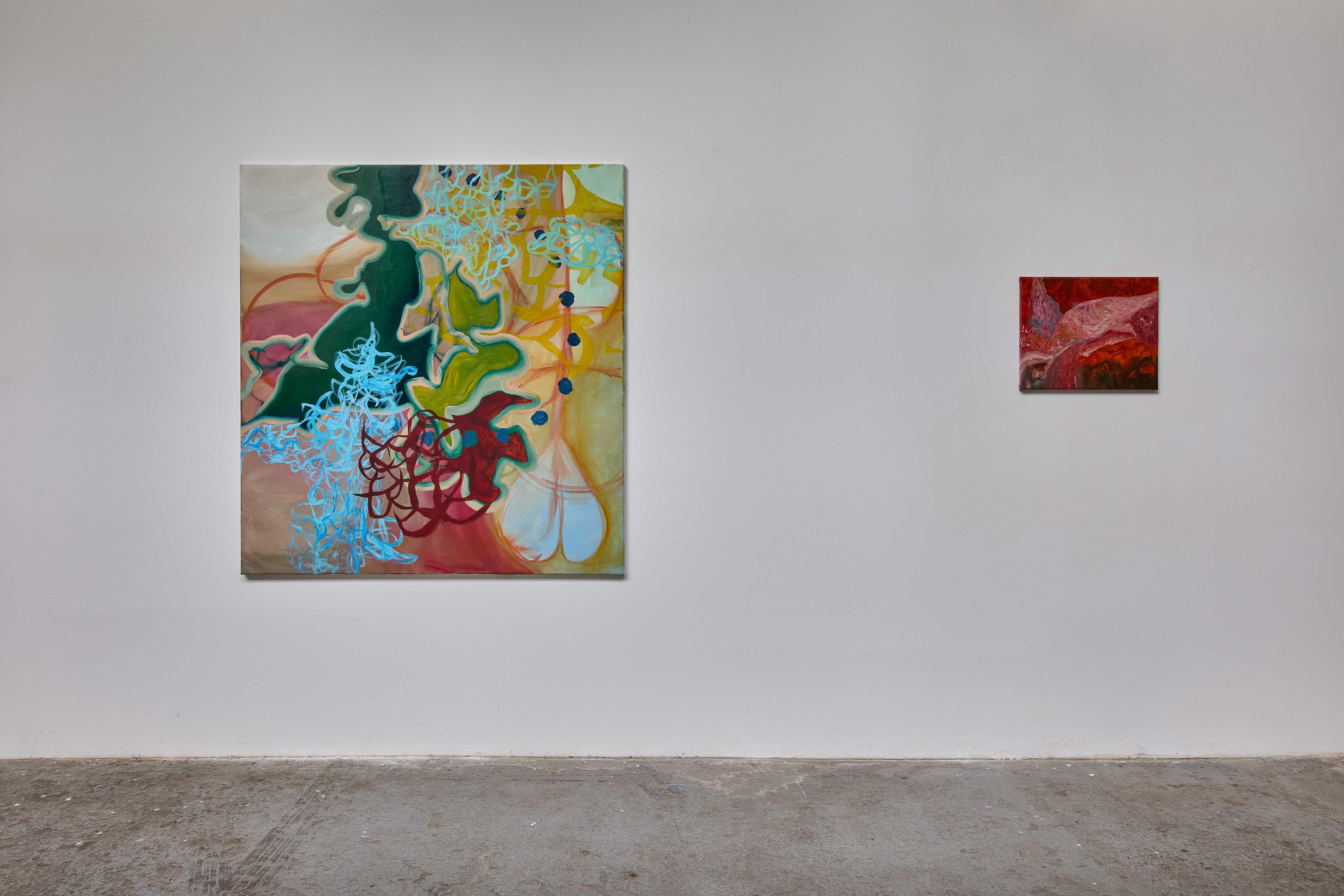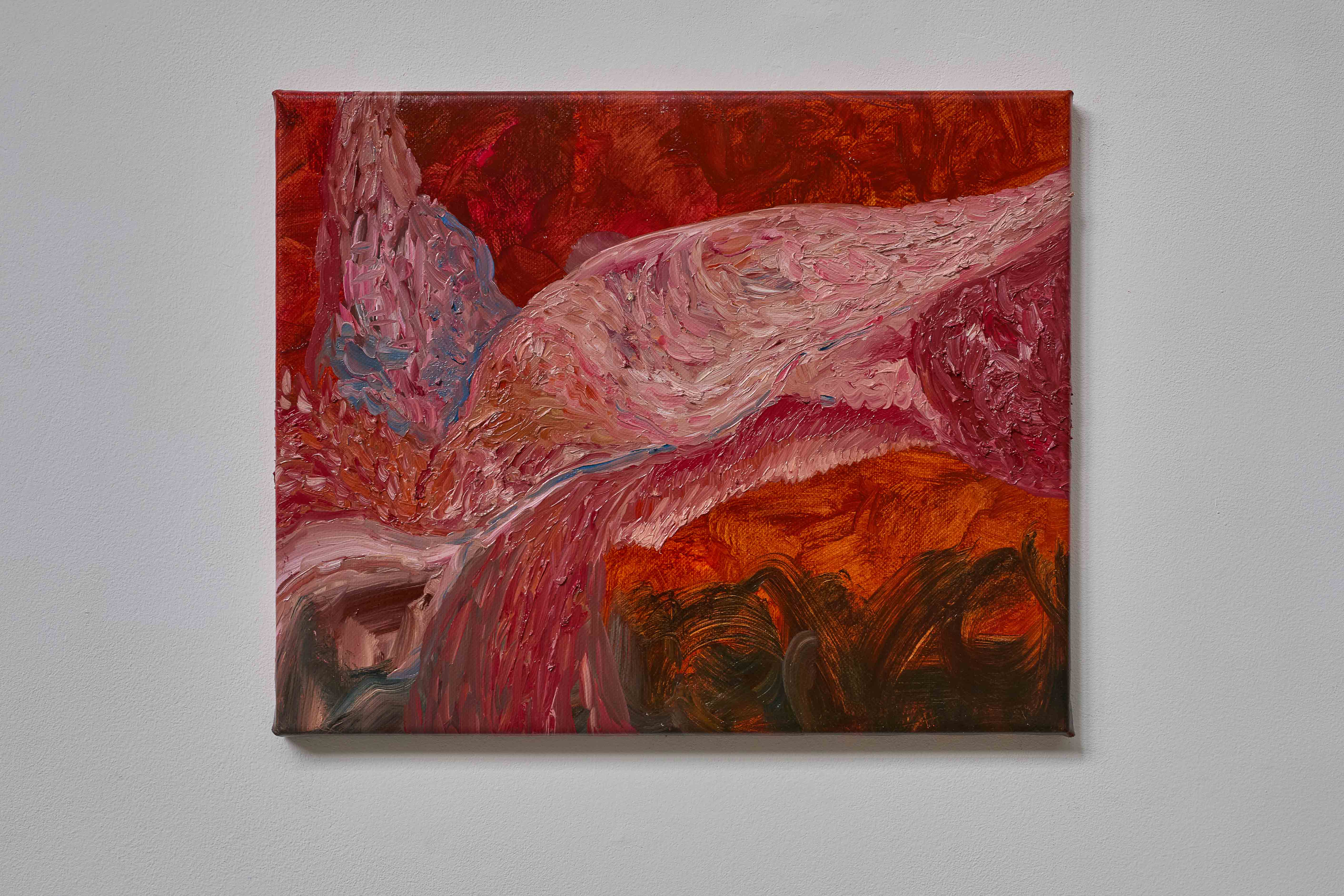Markéta Adamcová: Noise of a Dense Life
curated by: Natálie Kubíková, Mia Milgrom
opening 28.6. (6 pm)
29.6. - 31.7. 2024
ENG// Markéta Adamcová's exhibition, "Noise of a Dense Life," delves into the themes of mortality, generational trauma, and corporeal vulnerability. Her work highlights the importance of understanding history and family constellations as key factors in understanding our current state and behavior. The work reflects not only the physical side of organisms but also their mental and emotional components. Through abstract forms and color combinations, it seeks to express the complexity of life and its various phases and transformations. The exhibition "Noise of a Dense Life" is thus a metaphorical response to the processes that accompany the existence and extinction of every living creature. Through her work as a painter and poet, Markéta Adamcová transforms these personal situations and narratives into vivid colors and genuine words.
"A Movement," a poem written by Adamcová, places us in a garden as observers of the everlasting but cyclical life within it. The bugs, the smells, the weather—each movement perpetuates the next, existing without regard to our pains or histories. Her writing mirrors losing track of time or even losing oneself to solitude, understanding both alienation and the deep familial interdependencies.
Markéta Adamcová explores generational trauma and inherited pain that ripple through families and communities across vast spaces through the ideas of Judith Butler, Gabor Maté, and poets such as Etel Adnan and John Donne. She talks about her personal loss and numbness in connection to the atrocities we are collectively allowing as humanity. Butler similarly asks us to consider which lives are deemed grievable and whose suffering is acknowledged. Her work underscores the ethical imperative to recognize the value of all lives and to mourn and heal collectively. “Capacious care,” a term introduced in "The Care Manifesto: The Politics of Interdependence" (Verso, 2020), places importance on caring for strangers and distant others, advocating for a universal care that “cultivates and prioritizes the social, institutional, and political facilities that enable and enhance our capacities to care for each other and the natural world.”
The author draws from literature, visual arts, and natural motifs, which in her interpretation are intertwined on paper collages, drawings, or large, colorful canvases through abstract figures and organic shapes. What we consider solid matter here is perforated, and what is supposed to be as fragile as a leaf, on the contrary, represents the strongest link between the interwoven images. The mutually revealing layers on the canvases allow their depth to permeate, so we can observe several scenes at once, as if we were rapidly watching the growth of a stem from the soil and at the same time its withering and decay. Everything grows through and mixes, the canvases connect and refer to each other as well as to parts of the author’s poems. A tiny fly under the painter’s microscope gleams in several color spectrums right before our eyes, while we try to figure out if it will ever take flight again.
A movement
A wide step over the raspberry tendon
sticking its canine into her calf
I found carrion, half buried by the unmowed stalks
Under buzzing ivy crowns
Springtime
seeing it as a parasite,
hacking its stems embracing the spruce's trunk,
arteries of this soil
Filled with rage, especially filled with pity, at once
All blooms, treetops are nourishing the bees as their mother
with thousands of tiny breasts
Warm animal stench, noise of a dense life
Intruders are never able to see themselves for who they are,
that's all
The aged pear's talons reach towards the house,
grasping the puny twisted fingers of golden rain
I immersed my arms into the clay's cold depths
to scoop the ancient frost into the dry August glow
Over the centuries
dark matter was fed by carcasses
CZ// Markéta Adamcová se na výstavě "Noise of a Dense Life" zabývá tématy smrtelnosti, generačního traumatu a tělesné zranitelnosti. Její práce zdůrazňuje důležitost porozumění historii a rodinným konstelacím jakožto klíčovým faktorům pro pochopení našeho současného stavu a chování. Práce reflektuje nejen fyzickou stránku organismů, ale i jejich duševní a emocionální složku. Skrze abstraktní formy a barevné kombinace se snaží vyjádřit komplexnost života a jeho různé fáze a transformace. Výstava "Noise of a Dense Life" je tak metaforickou odezvou na procesy, které provázejí existenci a zánik každého živého tvora. Autorka prostřednictvím své malířské a básnické tvorby převádí tyto osobní situace a vyprávění do živých barev a upřímných textů.
Báseň "The Movement" (Pohyb) nás přivádí do zahrady jako pozorovatele věčného, cyklického života, který se v ní odehrává. Brouci, pachy, počasí—každý pohyb umožňuje vznik toho dalšího, vše existuje bez ohledu na naše trápení či osobní historii. V jejích textech se zrcadlí ztráta časovosti, nebo dokonce ztráta sebe sama v samotě, pochopení pro odcizení i hluboké rodinné vztahy.
Adamcová zkoumá generační traumata a zděděné bolesti, které se šíří v rodinách a komunitách napříč rozsáhlým prostorem skrze myšlenky Judith Butler, Gabora Maté a básníků, jako jsou Etel Adnan nebo John Donne. O své osobní ztrátě mluví také v souvislosti se zvěrstvy, která jako lidstvo kolektivně připouštíme. Butler nás podobně vyzývá, abychom se zamysleli nad tím, které životy jsou považovány za hodnotné a čí utrpení je vůbec vnímáno jako opravdové. Zdůrazňuje etický imperativ uznat hodnotu všech životů a kolektivního truchlení a hojení. "Kapacitní péče," termín zavedený v "Manifestu péče" (The Care Manifesto: The Politics of Interdependence, Verso 2020), klade důraz na péči o cizí a vzdálené lidi, na univerzální péči, která "kultivuje a upřednostňuje sociální, institucionální a politické zázemí, jež umožňuje a posiluje naše schopnosti pečovat o sebe navzájem a o přirozený svět."
Autorka čerpá z literatury, vizuálního umění a přírodních motivů, které v jejím podání proplétá na papírových kolážích, kresbách nebo rozměrných, barevných plátnech, skrze abstrahované postavy a organické tvary. To, co považujeme za pevnou hmotu, je zde proděravělé, a to, co má být křehké jako list stromu, zde naopak představuje tu nejsilnější spojku mezi propletením jednotlivých obrazů. Vzájemně se odkrývající vrstvy na plátnech nechávají prostoupit jejich hloubku, takže můžeme sledovat několik scén najednou, jako bychom zrychleně pozorovali růst stonku z hlíny a zároveň jeho uvadání a tlení. Vše prorůstá a mísí se, plátna na sebe navazují a odkazují jedno na druhé i na části autorčiných básní. Malá muška pod malířským mikroskopem se blyští v několika barevných spektrech přímo před našima očima, zatímco se snažíme přijít na to, jestli ještě někdy vzlétne.
photos by: shotby.us
graphic design: SelmeciKockaJusko
curated by: Natálie Kubíková, Mia Milgrom
opening 28.6. (6 pm)
29.6. - 31.7. 2024
ENG// Markéta Adamcová's exhibition, "Noise of a Dense Life," delves into the themes of mortality, generational trauma, and corporeal vulnerability. Her work highlights the importance of understanding history and family constellations as key factors in understanding our current state and behavior. The work reflects not only the physical side of organisms but also their mental and emotional components. Through abstract forms and color combinations, it seeks to express the complexity of life and its various phases and transformations. The exhibition "Noise of a Dense Life" is thus a metaphorical response to the processes that accompany the existence and extinction of every living creature. Through her work as a painter and poet, Markéta Adamcová transforms these personal situations and narratives into vivid colors and genuine words.
"A Movement," a poem written by Adamcová, places us in a garden as observers of the everlasting but cyclical life within it. The bugs, the smells, the weather—each movement perpetuates the next, existing without regard to our pains or histories. Her writing mirrors losing track of time or even losing oneself to solitude, understanding both alienation and the deep familial interdependencies.
Markéta Adamcová explores generational trauma and inherited pain that ripple through families and communities across vast spaces through the ideas of Judith Butler, Gabor Maté, and poets such as Etel Adnan and John Donne. She talks about her personal loss and numbness in connection to the atrocities we are collectively allowing as humanity. Butler similarly asks us to consider which lives are deemed grievable and whose suffering is acknowledged. Her work underscores the ethical imperative to recognize the value of all lives and to mourn and heal collectively. “Capacious care,” a term introduced in "The Care Manifesto: The Politics of Interdependence" (Verso, 2020), places importance on caring for strangers and distant others, advocating for a universal care that “cultivates and prioritizes the social, institutional, and political facilities that enable and enhance our capacities to care for each other and the natural world.”
The author draws from literature, visual arts, and natural motifs, which in her interpretation are intertwined on paper collages, drawings, or large, colorful canvases through abstract figures and organic shapes. What we consider solid matter here is perforated, and what is supposed to be as fragile as a leaf, on the contrary, represents the strongest link between the interwoven images. The mutually revealing layers on the canvases allow their depth to permeate, so we can observe several scenes at once, as if we were rapidly watching the growth of a stem from the soil and at the same time its withering and decay. Everything grows through and mixes, the canvases connect and refer to each other as well as to parts of the author’s poems. A tiny fly under the painter’s microscope gleams in several color spectrums right before our eyes, while we try to figure out if it will ever take flight again.
A movement
A wide step over the raspberry tendon
sticking its canine into her calf
I found carrion, half buried by the unmowed stalks
Under buzzing ivy crowns
Springtime
seeing it as a parasite,
hacking its stems embracing the spruce's trunk,
arteries of this soil
Filled with rage, especially filled with pity, at once
All blooms, treetops are nourishing the bees as their mother
with thousands of tiny breasts
Warm animal stench, noise of a dense life
Intruders are never able to see themselves for who they are,
that's all
The aged pear's talons reach towards the house,
grasping the puny twisted fingers of golden rain
I immersed my arms into the clay's cold depths
to scoop the ancient frost into the dry August glow
Over the centuries
dark matter was fed by carcasses
- Markéta Adamcová
CZ// Markéta Adamcová se na výstavě "Noise of a Dense Life" zabývá tématy smrtelnosti, generačního traumatu a tělesné zranitelnosti. Její práce zdůrazňuje důležitost porozumění historii a rodinným konstelacím jakožto klíčovým faktorům pro pochopení našeho současného stavu a chování. Práce reflektuje nejen fyzickou stránku organismů, ale i jejich duševní a emocionální složku. Skrze abstraktní formy a barevné kombinace se snaží vyjádřit komplexnost života a jeho různé fáze a transformace. Výstava "Noise of a Dense Life" je tak metaforickou odezvou na procesy, které provázejí existenci a zánik každého živého tvora. Autorka prostřednictvím své malířské a básnické tvorby převádí tyto osobní situace a vyprávění do živých barev a upřímných textů.
Báseň "The Movement" (Pohyb) nás přivádí do zahrady jako pozorovatele věčného, cyklického života, který se v ní odehrává. Brouci, pachy, počasí—každý pohyb umožňuje vznik toho dalšího, vše existuje bez ohledu na naše trápení či osobní historii. V jejích textech se zrcadlí ztráta časovosti, nebo dokonce ztráta sebe sama v samotě, pochopení pro odcizení i hluboké rodinné vztahy.
Adamcová zkoumá generační traumata a zděděné bolesti, které se šíří v rodinách a komunitách napříč rozsáhlým prostorem skrze myšlenky Judith Butler, Gabora Maté a básníků, jako jsou Etel Adnan nebo John Donne. O své osobní ztrátě mluví také v souvislosti se zvěrstvy, která jako lidstvo kolektivně připouštíme. Butler nás podobně vyzývá, abychom se zamysleli nad tím, které životy jsou považovány za hodnotné a čí utrpení je vůbec vnímáno jako opravdové. Zdůrazňuje etický imperativ uznat hodnotu všech životů a kolektivního truchlení a hojení. "Kapacitní péče," termín zavedený v "Manifestu péče" (The Care Manifesto: The Politics of Interdependence, Verso 2020), klade důraz na péči o cizí a vzdálené lidi, na univerzální péči, která "kultivuje a upřednostňuje sociální, institucionální a politické zázemí, jež umožňuje a posiluje naše schopnosti pečovat o sebe navzájem a o přirozený svět."
Autorka čerpá z literatury, vizuálního umění a přírodních motivů, které v jejím podání proplétá na papírových kolážích, kresbách nebo rozměrných, barevných plátnech, skrze abstrahované postavy a organické tvary. To, co považujeme za pevnou hmotu, je zde proděravělé, a to, co má být křehké jako list stromu, zde naopak představuje tu nejsilnější spojku mezi propletením jednotlivých obrazů. Vzájemně se odkrývající vrstvy na plátnech nechávají prostoupit jejich hloubku, takže můžeme sledovat několik scén najednou, jako bychom zrychleně pozorovali růst stonku z hlíny a zároveň jeho uvadání a tlení. Vše prorůstá a mísí se, plátna na sebe navazují a odkazují jedno na druhé i na části autorčiných básní. Malá muška pod malířským mikroskopem se blyští v několika barevných spektrech přímo před našima očima, zatímco se snažíme přijít na to, jestli ještě někdy vzlétne.
photos by: shotby.us
graphic design: SelmeciKockaJusko














